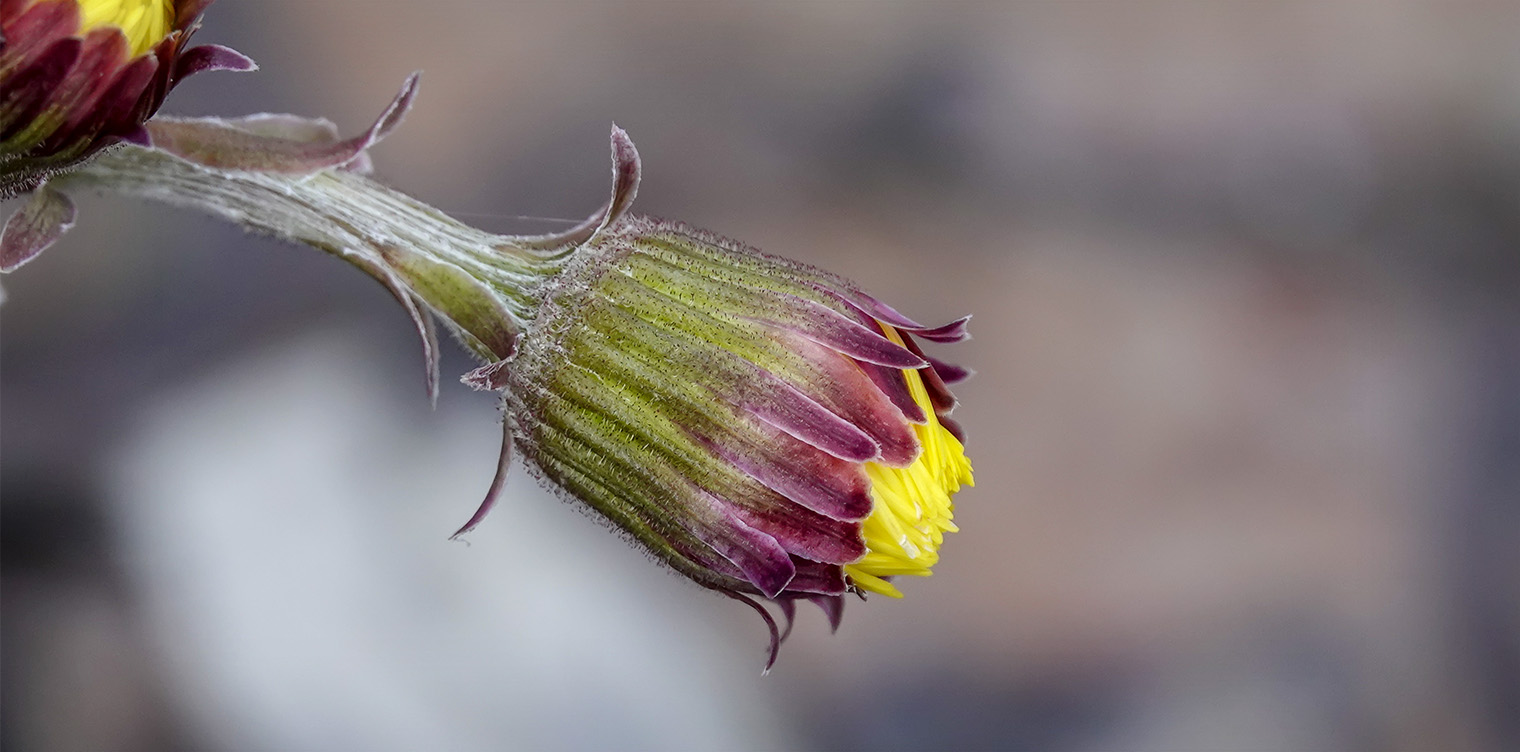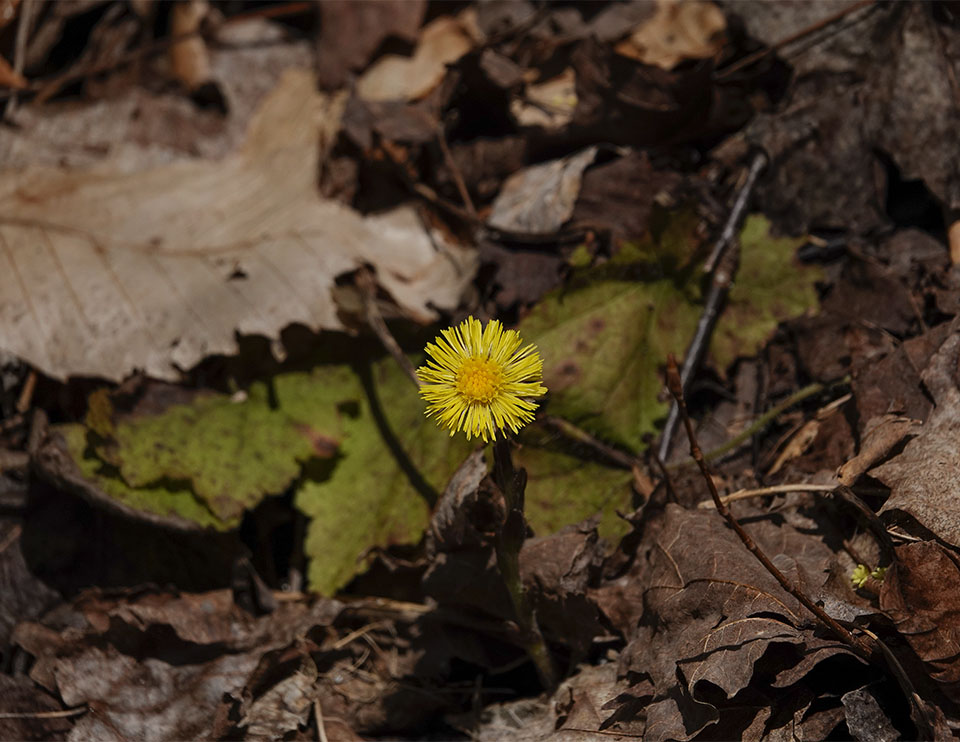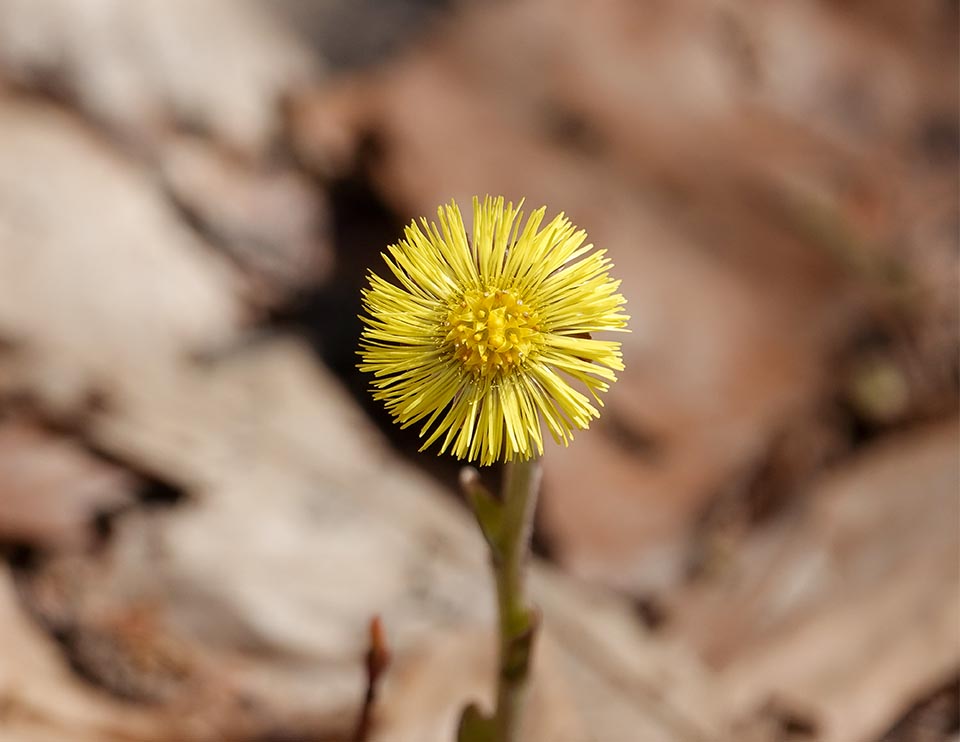Wildflowers of the Adirondacks:
Coltsfoot (Tussilago farfara)

Coltsfoot (Tussilago farfara) is a nonnative plant which bears small, bright yellow flowers in early spring. Its dandelion-like flowers appear before the foliage.
The common name refers to the resemblance of the leaf to a colt's foot. The genus name (Tussilago) comes from the Lain tussis ("a cough") – a reference to the purported curative powers of Coltsfoot for this ailment. The plant is also known as Son-before-Father; this is a reference to the fact that the flowers appear before the leaves.
This plant is a member of the Aster family. It is not native to the US. It is native to Eurasia, including parts of northern Africa, India, and Nepal. The species was probably introduced to North America by early settlers for its presumed medicinal properties.
The species is becoming an invasive weed in some areas. It is classed as a Class A noxious weed in Alabama and an "A" designated weed in Oregon. It is prohibited in Massachusetts. It is considered an invasive species in Connecticut and banned in that state.
Identification of Coltsfoot

Coltsfoot is a relatively small plant, growing three to 18 inches high. Its flowering stems are covered with woolly hairs and emerge in early spring prior to the leaves.
Coltsfoot usually blooms in this part of the Adirondack Park in late April or early May, depending on the weather. The bright yellow flowers are about an inch wide and resemble those of the dandelion. The flowering heads close at night and on cloudy, rainy days.
The leaves which develop later are toothed, shallowly lobed, and covered with white fuzz on the underside. The leaves grow in the form of a basal rosette.
Uses of Coltsfoot
Although some sources caution that the plant may be toxic in large doses, Coltsfoot has been used as both a food and a medicine. The flower buds and young flowers reportedly can be eaten raw or cooked. They can be used in salads or added to soups. The fresh of dried leaves and flowers can also be used to make tea.
Coltsfoot also has some medicinal uses. In Europe, this plant is said to be popular as a remedy for a wide range of chest complaints. The dried leaves reportedly can be used to make Coltsfoot tea. The plant was very little used by native Americans, although the Iroquois used an infusion of roots as cough medicine.
Wildlife Value of Coltsfoot
Coltsfoot's value to wildlife is minimal. It reportedly is used as a food plant by some butterfly and moth species and also provides pollen and nectar to honeybees.
Distribution of Coltsfoot

Coltsfoot is most widespread in the eastern United States from Minnesota south to Tennessee, east to North Carolina, and north to Maine. It occurs throughout southern Ontario, southern Quebec, and the Canadian Maritime provinces. It is also found in southwestern British Columbia and Vancouver Island.
Coltsfoot is present in most counties of New York State, including most within the Adirondack Park Blue Line.
Habitat of Coltsfoot
In terms of soil, moisture, and site requirements, Coltsfoot is quite flexible. This species occurs in a wide variety of soils, including clays, silts, loams, silt loams, silty clay loams, sandy loams, and sands. It can grow in infertile to very fertile soils. It prefers moist soils, but can also grow in drier areas, in partial shade or full sun.
As a result, Coltsfoot occurs in a variety of habitats and plant communities throughout the United States and Canada. The plant is seen most frequently in disturbed open areas, such as roadsides. However, it is also found in forest edges, old fields, and in forested areas which have experienced some form of disturbance, such as trail construction or fire. Look for Coltsfoot along selected trails at the Paul Smiths VIC and the Big Field Loop at Heaven Hill.
References
Michael Kudish. Adirondack Upland Flora: An Ecological Perspective (The Chauncy Press, 1992), p. 210.
New York Flora Association. New York Flora Atlas. Colts-foot. Tussilago farfara L. Retrieved 8 March 2022.
United States Department of Agriculture. The Plants Database. Tussilago farfara L. Coltsfoot. Retrieved 8 March 2022.
United States Department of Agriculture. Fire Effects Information System (FEIS). Species Reviews. Tussilago farfara. Retrieved 8 March 2022.
Flora of North America. Tussilago farfara Linnaeus. Retrieved 21 March 2017.
iNaturalist. Colt's-Foot. Tussilago farfara. Retrieved 8 March 2022.
iNaturalist. Adirondack Park Observations. Colt's-Foot. Tussilago farfara. Retrieved 8 March 2022.
New York State. Department of Environmental Conservation. New York Natural Heritage Program. Ecological Communities of New York State. Second Edition (March 2014), p. 128. Retrieved 17 October 2015.
Connecticut Botanical Society. Coltsfoot. Tussilago farfara. Retrieved 8 March 2022.
University of Wisconsin. Flora of Wisconsin. Tussilago farfara L. Retrieved 8 March 2022.
NatureServe Explorer. Tussilago farfara - L. Retrieved 8 March 2022.
Plants for a Future. Tussilago farfara - L. Retrieved 8 March 2022.
University of Michigan. Native American Ethnobotany. A Database of Foods, Drugs, Dyes and Fibers of Native American Peoples, Derived from Plants. Tussilago farfara L. Coltsfoot. Retrieved 21 March 2017.
Lawrence Newcomb. Newcomb's Wildflower Guide (Little Brown and Company, 1977), pp. 358-359.
Roger Tory Peterson and Margaret McKenny. A Field Guide to Wildflowers. Northeastern and North-central North America (Houghton Mifflin Company, 1968) pp. 110-111. Retrieved 8 March 2022.
National Audubon Society. Field Guide to Wildflowers. Eastern Region (Alfred A. Knopf, 2001), pp. 421-422.
William K. Chapman, et al. Wildflowers of New York in Color (Syracuse University Press, 1998), pp. 94-95.
Anne McGrath. Wildflowers of the Adirondacks (EarthWords, 1981, 2000), p. 76, Plate 21. Retrieved 8 March 2022.
Ruth Schottman. Trailside Notes. A Naturalist's Companion to Adirondack Plants (Adirondack Mountain Club, 1998), pp. 26-29.
